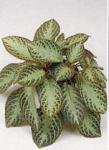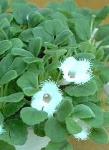|
|
EpisciaFamily: Gesneriaceae.
|
Common name(s): Flame violet, Lace Flower |
Episcia dianthiflora H. E. Moore et R. G. Wils. (Lace Flower), Alsobia diantiflora. |
 |
Genus of 6 species of creeping, stoloniferous, mat-forming, epiphytic or terrestrial, evergreen perennials founs in tropical forest and rocky habitats from Mexico to South America. Episcia is an attractive trailing plant. Because it requires high air humidity it is often difficult to grow as an isolated plant or in hanging basket, but it makes an excellent ground cover between taller plants. There are two main tipes - The Flame Violet And the delicate Lace Flower. The Flame Violet has the more eye-catching leaves - large and quilted with silvery or pale green veins. The trailing stems grow about 1,5 ft long - with the Lace Flower (Episcia dianthiflora) the small leaves are borne in groups along thread-like runners. Both bloom throughout the summer and the runners root in surrounding compost, forming plantlets for propagation. Shorten stems after flowering. |
 |
| Growing conditions |
Watering and misting |
Propagation |
| Average or above average warmth in summer. Keep fairy cool in winter - minimum temperature 60 F. Bright light - avoid direct sunshine. |
Water freely from spring to autumn - sparingly in Winter. Use tepid water. Mist leaves frequently, especially in hot weather. |
Take stem cuttings in spring. Use a rooting hormone and provide bottom head. Surface-sow seed at 68-77 F (20-25 C) as soon as ripe or in early spring. Devide, separate plantlets. |
|
These materials are freely provided for instructional and educational purposes. Any duplication or publication of text or images herein for commercial gain without explicit written permission of the owner or photographer constitutes breach of trust and violation of copyright.
Copyright © Galka Okhapkina 1998-2025


